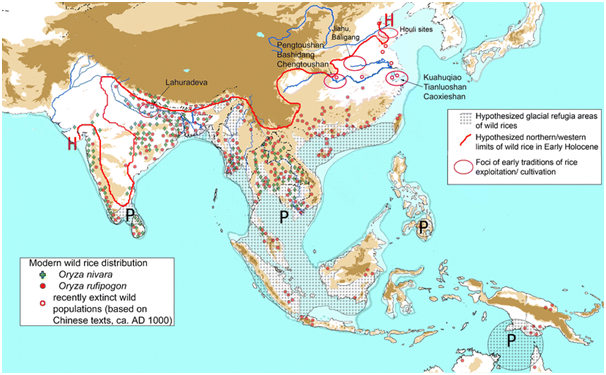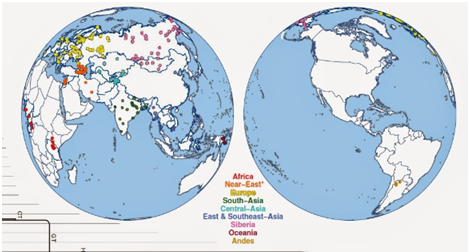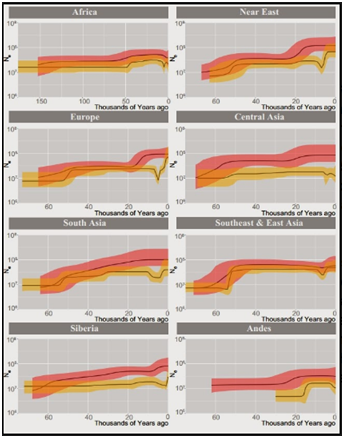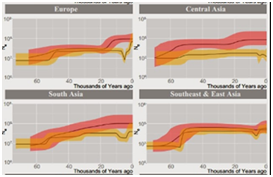Earlier published in www.pgurus.com in three parts:
Part 1, Part 2 and Part 3
The preliminary findings of a DNA study of the skeletal remains of Rakhigarhi dated at 6000 years BP and reported in Economic Times on 13th June 2018 reveal that there was no trace of Central Asian ancestry. Mr Vasant Shinde, one of the authors of the study says, “This indicates quite clearly, through archeological data, that the Vedic era that followed was a fully indigenous period with some external contact.”
Another author, Mr Neeraj Rai who did the DNA study says that the findings point to “greater continuity rather than to a new Aryan race descending and bringing superior knowledge systems to the region.”
While these are on expected lines concurring with the indigenous history of ancient India as known from the Itihasas, it is necessary to know the reaction from the other side of the fence. One of the prominent proponents of Aryan Invasion Theory, Mr Witzel had reacted to this news in one of the group-forums as follows:
“.. “proving” the same: ancient DNA (just 2 persons) from the Indus site of Rakhigarhi, long bandied about, now is said to show that their DNA was *not* that of “invading Aryans.”
Of course, in a Harappan site we would not expect W. Central Asian (Indo-Aryan) DNA, as the recent paper by Vagheesh et al. indicated: the *speakers* of Indo-Aryan entered the subcontinent only in the LATE Bronze Age: as evidence from Swat indicates.
For a nationalist/Hindutva person that does not matter, of course, as they wrongly maintain that the Harappan population was “Aryan” anyhow.
Problem solved, LOL.”
It is amusing to read this reaction with many pitfalls contained. Let me discuss them one by one.
Sample size
At the outset he seems to take a dig at the number of samples taken for the study. The samples were taken from just two persons. Can any conclusive word be given on a well-oiled theory like the AIT, from just 2 specimens?
Why not? If 92 scientists (Vagheesh M.Narasimhan and others /Narasimhan et al) can justify Aryan Invasion or rather, the movement of Indo-Aryan speakers to India on the basis of *zero* samples from the Indus region, the Shinde-Rai pair sounds more reliable when they made their claim on *just* 2 samples.
Thankfully, Narasimhan et al adhered to academic integrity by conceding that they have no “access to any DNA directly sampled from the Indus Valley Civilization (IVC)” , but built up an hypothesis of an ancestry to IVC from outside Indus (Indus Periphery). In their own words,
“Without ancient DNA from individuals buried in IVC cultural contexts, we cannot rule out the possibility that the group represented by these outlier individuals, which we call Indus_Periphery, was limited to the northern fringe and not representative of the ancestry of the entire Indus Valley Civilization population.” (lines 293-295)
“Indus Periphery-related people are the single most important source of ancestry in South Asia.” (Abstract)
Contrast this with the findings of Shinde-Rai which is based on the genetic material extracted from 2 specimens, found in a core IVC location from a layer of 6000 years BP and arriving at a conclusion that it is predominantly a local element and did not contain any central Asian genetic element. This is not a hypothesis but a finding. Can we say the same for the conclusion of Narasimhan et al? Theirs is a hypothesis – a ‘possibility’.
The Swat evidence
Perhaps in realisation of this fact, Mr Witzel switches over to finding an excuse for the absence of Central Asian element in the genetic material of Rakhigarhi specimen. He expresses in the next line of his comment that he doesn’t expect Central Asian gene in any Harappan site, meaning to say that they would appear in the genetic make-up only after the Aryan Invasion had started – i.e., from the middle of the 2nd millennium BCE.
To support this he quotes the paper by Narasimhan et al on Swat-evidences. But then the Swat evidence speaks about an admixture of Iranian-agriculturists and South Asian hunter-gatherers (AASI) in 4700- 3000 BCE in outliers of BMAC and eastern Iran that was genetically similar to post-IVC groups of Swat region thousand years later (1200-800 BCE). This group is favoured by Narasimhan et al as forming “the single most important source of ancestry in South Asia.”
The fact of the matter is that there is NO central Asian ancestry in this group claimed by Mr Witzel as evidence from Swat (on subsequent Aryan Invasion). The admixture in Indus periphery / Swat is made of 58% – 86% of Iranian agriculturists related ancestry with “little Anatolian agriculturist related admixture” and 14%-42% AASI ancestry. On the other hand Shinde-Rai study shows minor traces of Iranian strains in Rakhigarhi which, going by the time period of the specimens, would be ancestral to Iranian genetic presence in Indus Periphery. In lay terms this means out of India movement of Iranian strains which however have to be corroborated by the exact strains found out in the study and made known once the paper is published.
Can language be identified by genetics?
Another issue in Mr Witzel’s comment is about how he pinpoints the identity of the people that he calls Aryans. He identifies them by the language – “the *speakers* of Indo-Aryan”.
I never knew that linguistic research can be so easy that just by studying the genetic origins of a person one can tell the language he spoke! If DNA can tell the language a person spoke, it is certainly not a big deal to identify the languages spoken by say, the pre-historic people of Adichanallur in South East Tamilnadu.
Dated at 2500-2200 BCE, the skeletal remains of Adichanallur were found to have belonged to four races, namely, Caucasoids, Mongoloids, Negroids and Australoids, with none of them resembling contemporary Tamil people (here).
Pic credit: The Hindu
The presence of these four races is absolutely not in sync with present day dwellers. How they reached this part of Tamilnadu from the presently known regions of these races might give a new migratory route. Instead if we link them with the language we speak, is it scientifically tenable to make a conclusion something like – that they brought Tamil to present-day Tamilnadu?
The Adichanallur specimens challenge one of the findings of the genetic study of Narasimhan et al. If Caucasoid had their origins in Central Europe or in central Steppe how did some of them reach this part of India at 2500-2200 BCE when their genetic markers were still hovering around BMAC between 2100 – 1700 BCE?
This means that there is many a slip in-between and Indian population history is not as easy as can be explained by an Aryan Invasion that is supposed to have brought a sophisticated language along with it. India’s location in a prime population blooming tropics, surrounded by oceans and drained by numerous rivers since Holocene offers a logical and plausible location for autochthonous growth of population with simultaneous growth of accessories like its own language and culture.
For saying this, if people like me are branded as “nationalist/ Hindutva person”, then the counter part of it makes the likes of Mr Witzel as anti-Indian and anti-Hindu, as Hindutva has its base in being a Hindu. Will he accept this identity for him?
Was Harappan Aryan?
Coming to the next and the last part of his comment, by rejecting the ‘Swat evidence’ of Narasimhan et al and subscribing to Shinde-Rai finding of indigenous strain in Rakhigarhi specimen, we are wrongly maintaining that Harappan was Aryan and be happy that ‘problem (is) solved’!
But the fact is that not just Harappan but the entire land of Bharat had been Aryan from an undated past. It was not caused by an Aryan Invasion. Central Asians or anybody could have come to India at any time or many times in the past, but how does it justify that they were the Vedic people?
In this entire issue of Aryan Invasion, one must be clear of what actually makes the culture Vedic?
Is it the spoke-wheeled chariot?
Yes, according to Mr Witzel. In the same comment on Rakhigarhi DNA study, he refers to the buried chariot excavated at Sinauli and observes,
“.. this is not a spoke-wheeled chariot but a cart with two *full* wheels, as is known from Harappa and Daimabad (see attached pictures). The usual confusion between chariots and wagons/carts, but exploited here for obvious political reasons : “No Aryan invasion” ”
Does the animal pulling the chariot determine Aryan-ness?
Yes, according to Mr Witzel. His further comment on Sinauli-finding goes like this:
“The draft animals will have been oxen, as in the Harappan and Daimabad cases. These were not “horse ridden chariots” as one newspaper had it : LOL.”
Spoke-wheeled chariot and horses determine the Aryan-ness and characterise the people as Vedic! Witzel and others quote the Vedas as authority for this!
Nothing can be more ridiculous and unscientific than this, as the very identity of the Vedic people is the fire ritual, the Yajna and not chariots and horses. Anybody from anywhere in the world could have had chariots and horses but the fire-ritual of the kind done in Vedic society is unique for the Vedic culture only.
The basic fire ritual of the Vedic culture is called ‘aupāsana’. Aupāsana is done every day at twilights throughout one’s life and at no time this fire is extinguished. From father to son, this fire travels down the generations endlessly. The fire for every other Vedic Yajna is taken from this Aupāsana fire. The one and only offering done in this fire is RICE.
Without rice no aupāsana can be done. Without aupāsana, no other yajna can be done and no Samskaras can be done. Rice is so basic to the Vedic society.
Now the question is, did the Central Asians know about rice?
They could have brought chariots and horses but did they bring rice – a grain very essential for doing the Vedic yajna?
Did they grow rice in the steppes or learnt about it anywhere en route to India identified by Witzel?
The simple fact is rice is not grown in those regions due to absence of supportive climatic conditions.
As per the AIT, they started Vedic life after reaching the IVC. But rice was already known to the IVC people and importantly in the present context of Rakhigarhi (IVC), a parallel archaeo-botanical study established that rice was grown in Rakhigarhi 6000 years ago!
This is proof enough that the central Asians who were supposed to have entered the IVC in the 2nd millennium BCE, had learnt the use of rice in the Yajna – assuming they developed the concept of Yajna by themselves – from the native, indigenous people of the IVC. A rational interpretation would however treat the central Asians as learning the very technique of Yajna from the natives and not as developing a Yajna all in a sudden by themselves and making the native rice as integral to the Yajna.
Rice, the staple food for natives of India from time immemorial also happens to be the staple food for Gods worshiped through Yajna. More importantly, in the Yajna for departed ancestors (sharadha) only cooked rice is offered. Having their ancestral homes in Central Asia, isn’t it illogical to expect them to have devised a Yajna for their ancestors in which the offering is a food that doesn’t grow in their ancestral land? So the role of rice in Vedic Yajna is something that defines the identity of the original Vedic Aryans.
Cultivation of rice in India predates the IVC.
The currently available proof on domestication of rice goes up to 9000 years ago in the Gangetic plain. Excavations done at Lahuradewa in the trans- Sarayū region showed that rice was the staple food for the people. Cultivation of wild rice in Lahuradewa dates back to an early period of Holocene. One can see the limits of rice cultivation in the figure given below, with the Indus region falling outside.

Map of wild rice zones since 20,000 BP (marked as P) in comparion to expansion since 9,000 BP (marked as H). Recent populations are marked in crosses and circles. (Fuller 2011)
The tropical climate and wetness have favoured domestication of rice in south east and eastern parts of India in the riverside regions from times before Indus civilization. This is proof of settled habitation in the Gangetic region much before Indus Valley Civilization started. Indus region is out of place in the rice map of early Holocene days.
The author (Fuller 2011) of the study (above figure) says in the abstract that ‘much dispersal of rice took place after Indo-Aryans and Dravidian speakers adopted rice from speakers of lost languages of Northern India’. This observation is influenced by the faulty and hypothetical division of people of India as Indo-Aryan and Dravidian. Like human genetics, rice-genetics is also assumed to reveal the speech of the people of the region! How unscientific!
Research by Upinder Singh (Singh 2008:110) has revealed the presence of cultivated rice of the variety Oryza sativa from the northern fringes of Vindhyas on the banks of Belan river up to Allahabad in the trans- Sarayū region. While Koldihwa and Mahagara in Allahabad show independent domestication of rice from 8th to 6th millennium BCE, the Neolithic sites in Son Valley in Madhya Pradesh has shown rice cultivation from 6th to 5th millennium BCE. Thus the Vindhya- Ganga- Ghaghara region is found to be the nuclear zone of rice domestication and cultivation from10,000 years BP. Delving on the same subject, Varma (2008:40-41) opines that this was not due to cultural diffusion from West Asia and South East Asia as one can find layers of evolution in the sites from Mesolithic to Neolithic culture.
The continuity or rather the spread of rice cultivation from east India to the Indus regions in the west was established by Petrie et al. The proof comes from Rakhigarhi!

In their paper Petrie et al established that rice was cultivated in Rakhigarhi even before the Indus Urban phase and observed that proximity of this region to the Ganges where the earliest domestication of rice was found in 7th millennium BCE “prompts the re-evaluation of the role of rice for Indus populations, and the way that it was transmitted from farther east”. This is a direct challenge to the view in support of AIT (Gangal et al. 2014) that farming entered India through Iran and Central Asia.
All the rice growing regions mentioned above were home to the Ikśvāku-s of Sarayū, Kuśikā–s of Viśvāmitra and Jamadagni–s of Vindhyas – the last two being Rig Vedic sages having close blood relationship. Jamadagni was Viśvāmitra’s sister’s son and they both were of same age. (MB 13.4, VP 4.7)
The trans- Sarayū region had shown human settlements as early as 6th to 5th millennium BCE along with evidence of rice cultivation. It is significant that the birth date of Rama established by Puṣkar Bhaṭnāgar in his book “Dating the Era of Lord Ram” using astronomy software on the planetary position given in Valmiki Ramayana falls on 5114 BCE, within this period.
Ramayana period falling within 6th -5th Millennium BCE perfectly matches with archaeo-genetic of rice domestication in trans-Sarayu region. The same period witnessed rice domestication in Vindhya-Ganga-Ghaghara region lending cross-referential support for the contemporariness of Viśvāmitra and Jamadagni with Rama – a feature well attested through another cross-referential source, namely Ramayana.
Rice domestication in Vindhya-Ganga-Ghaghara-trans Sarayū region strengthens the case for a Vedic society at that time. There is literary evidence for rice in Valmiki Ramayana (Iyengar 1997:31). A sage by name Trijaṭa used to collect a rice variety called ‘lāṅgalī’ scattered in the forest. Twice it is mentioned in Valmiki Ramayana about this sage subsisting on rice grains collected this way (VR 2.32.29 & 34). This rice could be either a wild variety growing in the forest or the left-over’s of cultivated variety after harvest.
The date of rice cultivation in Rakhigarhi a millennia later to trans-Sarayū –Vindhya region establishes the route of movement of cultivation of rice that forms the heart of the Vedic yajna.
What is the more rational of the two – the chariot driving Central Asians of the mid-2ndMillennium BCE, after halting at the IVC grabbing the rice from the indigenous people and inventing Vedic fire ritual or a continuing indigenous population, growing rice since 7th Millennium BCE and gradually developing Vedic culture where rice is central to fire rituals? Those in the know of Vedas would attest that Vedas and Vedic rituals could not have been developed in a few centuries but over a larger span of time (which would take another article to explain). So Mr Witzel, it is not nationalistic, but rationalistic to claim that Rakhigarhi was indigenously Vedic, and therefore Aryan!
References:
Fuller, D.Q. (2011). “Pathways to Asian Civilizations: Tracing the Origins and Spread of Rice and Rice Cultures”. RICE. 4(3-4). pp78-92. https://doi.org/10.1007/s12284-011-9078-7
Gangal K, Sarson GR, Shukurov A (2014) “The Near-Eastern Roots of the Neolithic in South Asia”. PLoS ONE 9(5): e95714. https://doi.org/10.1371/journal.pone.0095714
Ganguli, Kisari Mohan (Trans) (1883-1896). Mahabharatahttp://ancientvoice.wikidot.com/source:mahabharata
Griffith, Ralph T. H. (Trans) (1870-1874). Ramayan of Valmiki. http://www.sacred-texts.com/hin/rama/index.htm
Iyengar, Srinivasa C.R. (1997) (Trans). “Sakala Kāriya Siddhiyum, Srimad Rāmāayaṇamum” LIFCO Publication, Chennai. pp 29-32
Petrie, C., Bates, J., Higham, T., & Singh, R. (2016). “Feeding Ancient Cities in South Asia: Dating the Adoption of Rice, Millet and Tropical Pulses in the Indus Civilisation.”Antiquity. 90 (394). pp1489-1504. https://doi.org/10.15184/aqy.2016.210
Singh, Upinder (2008). A History of Ancient and Early Medieval India: From the Stone Age to the 12th Century. Pearson Education India. Delhi. pp 110-111.
Varma, Radha Kant (2008). “Beginnings of Agriculture in the Vindhya-Ganga Region”History of Agriculture in India (up to c.1200 A.D). Concept Publishing Company. New Delhi. pp 31-46
Recommended Reading for clarification of the yuga-time of Ramayana:
Yuga classification and how Yuga must be understood.
(Mailed to Mr Witzel)









